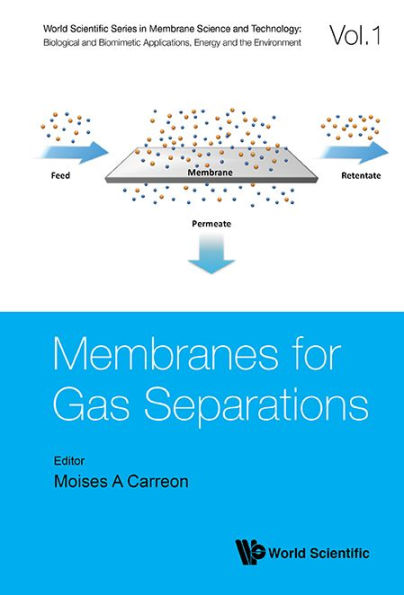Table of Contents
Preface v
1 Mixed Matrix Membranes for Gas Separation Applications Maria Carreon Ganpat Dahe Jie Feng Surendar R Venna 1
1 Introduction 1
2 Fabrication and Characterization of MMMs 4
3 Polymer-filler Compatibility 6
3.1 Filler Size and Morphology 9
3.2 Modification of the Fillers and Casting Conditions 11
3.3 Flat Sheet and Hollow Fiber Configurations 15
4 Gas Separation Performance of MMM 17
5 Zeolite-based MMM 19
6 MOF-based MMM 21
7 Carbon-based MMM 24
8 Other Novel Materials 28
8.1 Comparison of MMM with Inorganic Membranes 31
9 Predictive Models for Gas Separation Performance 33
10 Permeation Models 34
10.1 Ideal MMMs 34
10.1.1 Non-ideal MMMs 37
10.2 Molecular Models 43
11 Conclusions and Outlook 44
References 46
2 Ceramic-Supported Organic Composite Membranes for Gas Separation Gongping Liu Wanqin Jin 59
1 Ceramic-supported Polymeric Composite Membranes 60
2 Ceramic-supported GO Composite Membranes 66
2.1 Vacuum-filtration Method 67
2.2 Spray-evaporation Method 70
2.3 External Force-driven Assembly Method 74
2.4 Ceramic Hollow Fiber-supported GO Composite Membrane 80
2.5 Ceramic-supported GO Mixed Matrix Membranes 85
3 Conclusion and Outlook 91
Acknowledgments 92
References 92
3 Molecular Modeling of MOF Membranes for Gas Separations Ilknur Erucar Seda Keskin 97
1 Introduction 97
2 Computational Methods 105
2.1 Molecular Simulations of Thin-film MOF Membranes 106
2.2 Computational Modeling of MOF-based MMMs 113
3 Assessment of MOF Membranes using Computational Approaches 116
3.1 Thin-film MOF Membranes 117
3.2 MOF-based MMMs 126
4 Outlook 132
References 134
4 Membrane Processes for N2-CH4 Separation Shiguang Li Zhaowang Zong Miao Yu Moises A. Carreon 145
1 Natural Gas Generalities 146
2 Overview of Natural Gas N2 Rejection Technologies 148
2.1 Nitrotec Energy's PSA Process 149
2.2 Engelhard Molecular Gate 149
2.3 Mehra ProcessSM's Solvent Process 150
2.4 Bend Research Process 151
2.5 Membrane Process 151
3 Nitrogen-Selective Membranes 154
4 SAPO-34 Zeolites 155
5 SAPO-34 Membranes for N2-CH2 Separation 158
5.1 SAPO-34 Membranes Synthesis 159
5.1.1 Synthesis of SAPO-34 Seeds 159
5.1.2 Preparation of SAPO-34 Membranes 163
5.2 N2-CH2 Separation Performance of SAPO-34 Membranes 168
5.3 Adsorption Isotherms and Heats of Adsorption 182
6 Conclusions 188
References 189
5 Polymer Blend Membranes for Gas Separations Charles J. Holt Juan P. Vizuet Inga H. Musselman Kenneth J. Battens Jr. John P. Ferraris 195
1 Introduction 195
2 Morphology 208
2.1 Blends 210
2.2 Miscible Blends 211
2.3 Immiscible Blends 215
3 Morphology Control 218
3.1 Copolymers 218
3.2 Compatibilization 219
3.3 Immiscible Blends Compatibilized with Copolymers 219
3.4 Immiscible Blends Compatibilized with Nanoparticles and Small Molecules 221
4 Summary and Outlook 230
Acknowledgments 232
References 232
6 Manipulating Polyimide Nanostructures via Cross-linking for Membrane Gas Separation Lingxiang Zhu Maryam Omidvar Haiqing Lin 243
1 Introduction 243
2 Background on Membrane Gas Separation 245
3 Effect of Cross-linking on Polymer Physical Properties 247
4 Cross-linking of Polyimides for Membrane Gas Separation 251
4.1 Aromatic Polyimides for Gas Separation 251
4.2 Chemical Cross-Linking of Polyimides 254
5 Gas Separation Properties of Cross-linked Polyimides 256
5.1 H2-CO2 Separation 257
5.2 CO2-CH4 Separation 258
5.3 C3H6-C3H8 Separation 259
5.4 Correlation of Gas Permeability and Cross-Linking Density 260
6 Concluding Remarks 263
6.1 Summary 263
6.2 Outlook 263
Acknowledgment and Disclaimer 264
References 264
7 Dense Inorganic Membranes for Hydrogen Separation Sean-Thomas B. Lundin Neil S. Patki Thomas F. Fuerst Sandrine Ricote Colin A. Wolden J. Douglas Way 271
1 Introduction 272
2 Types of Dense Membranes 278
2.1 Hydrogen Soluble Metal Membranes (Thermochemical Transport) 278
2.1.1 Palladium and Its Alloys 282
2.1.2 BCC-Catalyst Combinations 285
2.2 Proton-Conducting Ceramic Membranes (Electrochemical Transport) 294
2.2.1 Oxides Based on the Perovskite Structure 296
2.2.2 Protonic Defects, Doping, and Transport Mechanism 297
2.2.3 Cerates Versus Zirconates 299
2.2.4 BaZrxCeyY1-x-yO3-δ (BZCY) and Solid-state Reactive Sintering (SSRS) 301
2.2.5 Hydrogen Galvanic Flux and Its Measurement 302
3 Hydrogen Separation Applications 305
3.1 Dehydrogenation Membrane Reactors 306
3.1.1 Proton-conducting Ceramic Applications 308
3.1.2 Steam Methane Reforming 310
3.1.3 Ammonia Decomposition 316
3.2 Hydrogenation Membrane Reactors 320
3.2.1 Dense Metal Membrane Applications 321
3.2.2 Dense Ceramic Membrane Applications 328
3.3 Hydrogen Isotope Separations 335
4 Summary and Outlook 338
Acknowledgments 341
References 341



